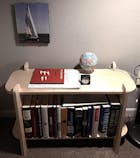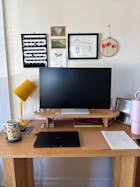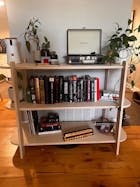Painting unfinished wood furniture is a simple way to protect the wood, save money, and customize your furniture to match your style. Here's what you'll learn in this guide:
- Preparation: Fill imperfections, sand the surface, and clean thoroughly for a smooth base.
- Choosing Paint and Primer: Pick the right type of paint (latex, oil-based, or chalk) and primer for durability and finish.
- Painting Techniques: Apply thin, even coats of primer and paint, sanding between layers for a polished look.
- Sealing: Use sealants like polyurethane or wax to protect the finish and enhance durability.
- Tools and Tips: Invest in quality brushes, rollers, and sandpaper, and always test on scrap wood first.
| Step | Key Tools | Time Required |
|---|---|---|
| Preparation | Sandpaper, wood filler | ~1-2 hours |
| Painting | Foam roller, quality brushes | 2-3 coats, drying time varies |
| Sealing | Polyurethane, wax | 2-3 coats, drying time varies |
Follow these steps to transform your furniture into a durable, custom masterpiece.
How To Paint Wood Furniture
1: Preparing the Wood Surface for Painting
Getting your furniture ready for painting is essential if you want a smooth, long-lasting finish. Proper preparation helps the paint stick better and ensures a polished final look.
Filling Wood Imperfections
Check your furniture for any holes, cracks, or dents. Use wood putty and a putty knife to fill these areas. Apply the putty slightly higher than the surface since it may shrink as it dries. Let it dry completely - usually about 24 hours.
Here’s what to use for different problems:
- Small holes: Standard wood putty
- Deep cracks: Two-layer putty
- Surface dents: Wood filler with hardener
- Knot holes: Epoxy filler
Sanding the Wood Surface
Use 220-grit sandpaper to create a smooth surface without scratches. Always sand along the wood grain, applying steady, even pressure. Pay close attention to the filled areas, blending them seamlessly with the rest of the wood.
Different woods may need special care. For example, pine can be tricky and may require a wood conditioner to avoid blotchy results [4]. For curved or intricate sections, a flexible sanding sponge works best.
Cleaning the Wood
Once sanding is done, vacuum the surface to remove dust and debris. Follow up with a tack cloth to pick up any remaining fine particles. The tack cloth’s sticky texture is perfect for grabbing what a regular cloth might miss.
"Not properly preparing the wood surface can lead to a rough, uneven finish and may cause the paint to peel or flake off prematurely."
Run your hand over the surface to ensure it feels smooth before moving on. This small step can save you from extra work later.
With the surface prepped and clean, you’re ready to pick the right paint and primer for your project.

2: Selecting Paint and Primer
Picking the right paint and primer is key to getting a polished, long-lasting finish on unfinished wood furniture. The right choice not only improves the look but also helps your work stand the test of time.
Types of Paint
Different paints work better for different furniture needs. Latex paint is great for everyday furniture because it's easy to clean and has low VOCs. Oil-based paint is tougher and works well for high-use pieces. If you're after a vintage look with less prep, chalk paint is a good option. Always pair your primer with the same type of paint (e.g., latex primer with latex paint) to ensure proper adhesion.
What about Spray Paint?
Spray paint is a fantastic option for quick, even coverage, especially on intricate or detailed pieces. It's often more affordable than traditional paint, making it an excellent choice for budget-friendly projects. Plus, the wide variety of finishes—from matte to glossy—offers versatility to match your style. While it doesn't require brushes or rollers, proper prep, such as sanding and using a spray-compatible primer, is key to achieving a professional look. Spray paint is also great for creating smooth, streak-free results with minimal effort, making it ideal for DIYers of all skill levels.

| Paint Type | Durability | Drying Time | Best For |
|---|---|---|---|
| Latex | Moderate | 1-2 hours | Everyday furniture |
| Oil-based | High | 24+ hours | High-traffic pieces |
| Chalk | Low-moderate | 1 hour | Vintage looks |
Think about how the furniture will be used. For example, a kitchen table needs the toughness of oil-based paint, while a decorative side table can handle chalk paint. Smooth woods like birch often pair well with latex paint for a clean finish.
Primer Choices
Primers come in a few varieties, each with its own strengths. Latex-based primers dry quickly and work for many projects. Oil-based primers are more durable and block stains effectively. If your wood has knots or tannins that could bleed through, a stain-blocking primer is your best bet.
Brands like Zinsser and Kilz are worth the investment for better adhesion and a smoother finish. Apply thin, even coats of primer instead of one thick layer to avoid drips and ensure a solid base for your paint.
Once you've chosen the right paint and primer, the next step is applying them carefully for a flawless result.
3: Painting Techniques for a Smooth Finish

With your wood prepped and primed, it's time to focus on painting techniques that will give your furniture a polished look. Achieving a smooth, professional finish requires the right approach and a bit of patience.
Applying Primer
For even coverage, use a foam roller on large surfaces and a brush for edges or detailed areas. Stick to thin, even coats to avoid drips and bubbles.
| Primer Type | Drying Time | Coats Needed |
|---|---|---|
| Latex-based | 1-2 hours | 1-2 |
| Oil-based | 24 hours | 1-2 |
| Stain-blocking | 2-4 hours | 2 |
After the first coat dries, inspect for any rough spots and sand them down if needed. Once the primer is fully dry and smooth, you're ready to start painting.
Applying Paint Coats
For flat surfaces, a foam roller works best, while a quality brush is ideal for corners and detailed areas. Work in small sections and keep the paint wet to avoid streaks. Applying 2-3 thin coats usually gives the best finish.
Paint in one direction, from top to bottom, for a consistent look. Ensure you're working in a stable environment to avoid issues like uneven drying. Let each coat dry completely before adding the next.
Sanding Between Coats
Use 220-grit sandpaper to gently roughen the painted surface between coats. This helps the next layer adhere better. Apply light pressure - you're just prepping the surface, not removing paint.
After sanding, clean the surface thoroughly to remove any dust before moving on to the next coat. This extra step ensures your final result is smooth and flawless.
sbb-itb-89f0495
4: Sealing and Protecting the Painted Finish
After your paint has dried completely, the last step is sealing the surface to ensure it lasts and looks polished. A sealant not only shields your work but also helps your furniture withstand daily wear.
Sealant Options
Pick a sealant that matches how the furniture will be used and the look you want:
| Sealant Type | Protection Level | Finish | Best For |
|---|---|---|---|
| Water-based Polyurethane | High | Glossy/Matte | High-traffic furniture |
| Natural Wax | Medium | Subtle Sheen | Decorative pieces |
| Oil-based Polyurethane | Very High | Warm Tone | Kitchen/bathroom furniture |
| Varnish | High | Glossy | Statement pieces |
Water-based polyurethane dries quickly (2-4 hours between coats) and has a low odor, making it a great choice for furniture that sees a lot of use. It’s also safer for indoor projects due to its lower chemical content [2].
Applying Sealants
Follow these steps to get the best results:
- Make sure the surface is completely dry and free of dust.
- Use a high-quality foam brush to apply thin, even coats.
- Work in small sections to avoid streaks and keep the sealant smooth.
"The most common mistake I see is rushing the sealing process", says a specialist at Real Milk Paint. "Taking time between coats and proper surface preparation makes the difference between an amateur and professional-looking finish." [1]
Lightly sanding between coats helps the sealant adhere better. Apply 2-3 thin coats in total, allowing enough drying time between each layer. Proper ventilation during application and curing is also crucial for a flawless finish.
For high-traffic furniture, water-based polyurethane provides excellent protection without altering the color. For decorative pieces, natural wax offers a softer look with moderate protection and an eco-friendly touch.
Additional Tips for Better Results
Achieving a polished look on unfinished wood furniture often comes down to the finer details. These small steps can have a big impact on how your project turns out.
Using the Right Tools
The tools you use can make or break your project. For example, angled brushes are ideal for precise detail work, while mini rollers are perfect for covering flat surfaces smoothly and efficiently. Investing in quality tools not only saves time but also ensures a clean, professional finish.
| Tool Type | Best For |
|---|---|
| Angled Brush | Edges and detailed areas |
| Mini Roller | Large, flat surfaces |
| Sandpaper | Smoothing between coats |
Testing on Scrap Wood
Before diving into your main project, try out your paint and techniques on a scrap piece of wood. This simple step can help you:
- Check how the color and finish will look.
- Practice your application method.
- See how layers build up for the final effect.
- Avoid mistakes that could ruin your furniture.
"The most valuable lesson I've learned is to always test first. A small piece of scrap wood can save you from ruining an entire furniture piece", says a specialist from Anika's DIY Life [1].
Opting for Low-VOC Paints
Low-VOC paints are a safer choice for indoor projects and still provide great coverage. These paints are better for your health and the environment, but they do require careful application. Always check for certifications and VOC information on the label before buying.
To get the best results with low-VOC paints:
- Let each coat dry thoroughly before adding another.
- Keep the room temperature steady while you work.
- Use natural primers and conditioners that pair well with these paints.
- Follow the manufacturer’s instructions closely.
Paying attention to these tips can help you create beautifully finished furniture that stands out in any space.
Conclusion: Personalize Your Furniture with Ease
Transforming unfinished furniture into a custom masterpiece is simpler than you might think. With the right approach, you can create pieces that are not only durable but also reflect your personal style.

Start by selecting quality materials. Acrylic latex paints and water-based polyurethane sealants are excellent choices for long-lasting results. If you're aiming for an eco-conscious project, water-based products work well for conditioning and sealing wood. Looking for something extra? Techniques like whitewashing pine with water-based stains can enhance the wood's natural charm while adding a unique touch [4].
Every step matters - prepping, painting, and sealing all contribute to a smooth, polished finish. Want to add personality? Try distressing for a vintage vibe, color washing for soft variations, or dry brushing for extra texture. Mix and match these methods to create a look that’s entirely your own, whether that means bold hues, understated tones, or retro-inspired details.
The DIY world is full of creative ideas and shared experiences. Whether you're revamping a cherished family piece or giving a thrift store find a second life, these techniques will help you craft furniture that stands out and stands the test of time.
Here are a few tips to keep in mind:
- Take your time with each step to achieve a polished result.
- Protect your work with a durable sealant.
- Experiment with various techniques to find the perfect finish.
- Use high-quality materials suited to your specific project.
FAQs
Here are answers to some common questions to help with your furniture painting project:
What kind of paint works best for unfinished furniture?
Water-based options like latex and acrylic paints are great for unfinished wood because they dry quickly and hold up well. If you're looking for an eco-conscious choice, Real Milk Paint can be applied directly to raw wood without needing a primer [2].
How many coats of paint are needed?
It's best to apply 2-3 thin coats. Make sure each layer dries completely before moving on to the next one [3].
Is priming necessary?
For most paints, priming helps ensure even coverage. However, Real Milk Paint sticks directly to raw wood, and chalk paint often doesn’t require primer for lighter projects [2].
How long should I wait before using the furniture?
After the final coat, give it at least 24 hours to dry before using the furniture [3].
What tools will I need?
You'll need a few essentials: 220-grit sandpaper, high-quality brushes, foam rollers, and a tack cloth to remove dust. Using the right tools makes the process easier and improves the final result [2][3].
These tips should set you up for a smooth and successful furniture painting experience!




























